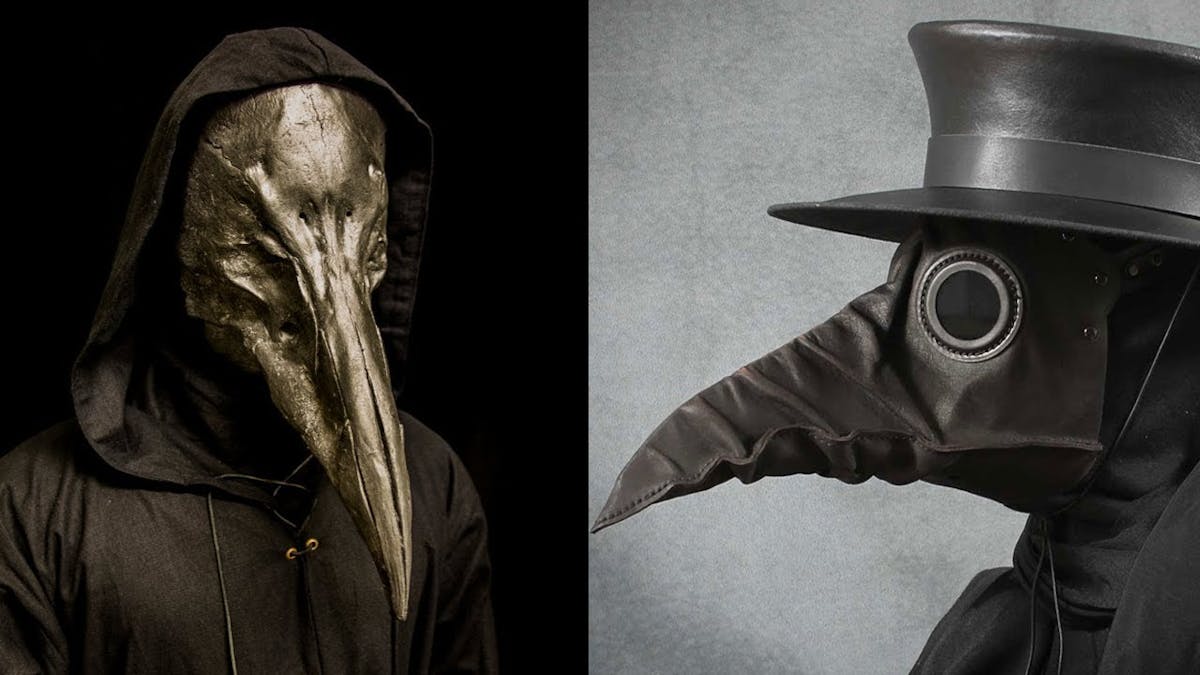The Plague Doctor

The Doctor is In
by Charles Spratley
A black robed figure comes through the night. His hat silhouetted by the many bonfires in the city streets. His mask a parody of a bird’s beak. The long wooden stick in his hand clacks as it strikes the cobblestones at his feet. The doctor has arrived. In trying times such as these right now I want us to look at the past. Being a teacher of history and a purveyor of the macabre, I cannot help but to cover the bubonic plague of the 14th Century, otherwise known as the Black Death. Out of this carnage will come the plague doctors, men who sacrificed all to bring aid to those suffering from this disease.
Bubonic Plague was first discovered in the Gobi Desert in 1320. By 1331 it reached China (probably via the Silk Road. In 1338 it appears in Russia, then India. Plague though, reaches the main European Continent in 1347, and by then there was no holding it back.
What exactly was the Black Death? It is the evolution of a bacterium known as Yersinia Pestis. This bacterium is usually found in small rodents, such as rats and marmots. It is believed that it originated in the grasslands and due to climate change, the rodents left the wild and fled to populated areas, where the dense population of a city would be the perfect breeding ground for the bacterium and nearly the death of us all. The first major pandemic is in China and it spread through the Eastern part of the continent like wildfire. It is commonly believed to come to Europe by Genoese traders from the port city of Kaffa in the Crimea. While the city was under siege by the Mongols, the invaders hurled their infected dead across the city walls using a catapult. The Genoese traders fled, taking the plague with them. They will make landfall in Sicily, and from there the plague will travel to the Italian mainland. In the end, it will kill almost 60% of the population of Europe, nearly 50 million people. This is the environment in which the plague doctor is born. And when disease struck, they were at the ready.
The plague doctor’s uniform changed as time progressed, but the most identifiable one is the costume thought to be invented by Charles de L’Orme in 1630. This though seems unlikely since their first use was in Italy and was first used in Naples, but like the disease, the fashion spread quickly. The coat was light, waxed to prevent fluids from penetrating it. He wore a brimmed hat, usually a symbol of an educated man, or a physician. The remainder of his outfit was usually trousers made of leather and boots and gloves to match. And, of course, the beaked mask with the glass eye openings. The beak had two small “nostrils” in it for air passage but the beak itself was filled with substances such as ambergris, mint leaves, storax, myrrh, laudanum, rose petals, camphor, cloves and straw. It was believed at the time, that the disease was caused by miasma, which was simply called “bad air” or “night air”. It was the theory that the foul odor of rotting organic material (such as human flesh) was causing the sickness. This proto gas mask was believed to prevent the doctor from getting the plague, which it did not. The medicine at the time was basic at best, barbaric at worst. There was no concept of germ theory and the populace didn’t realize that hygiene was the best protection against the plague.
The doctor’s main job was to investigate and determine if the patient was a victim of plague and if anything could be done for them. The stick they carried would be used to help diagnose the patient by examining them without having to actually touch the patient. Common treatments were bloodletting or placing frogs or leeches on the buboes (the swelling masses of the plague victim) in hopes of balancing the humors. It was also the job of the plague doctor to determine which houses and even which districts needed to be placed in quarantine to help stop the spread of the disease. Usually a crude “X” painted on the door let the populace know that everyone in the house may be infected and none should enter or leave. These doctors also did crude autopsies in hopes of diagnosis and kept records of infection. They were the first true municipal physicians. Cities would hire them and pay for their services and so they worked on patients both poor and rich. Their services were free, though from time to time it wasn’t unheard of for a doctor to sell a “cure”, which of course usually sped up the patient’s death.
As medicine progressed, the plague doctor became a thing of the past and was turned into the stuff of cartoons and nightmare fuel for small children. The famous beak became a popular mask used by many during Carnival, the festive parties leading up to Lent. It is not uncommon to see the Plague Doctor walking the streets of Venice amongst other party goers on their way to masked balls.
- Posted in:
- The Paranormal Library
